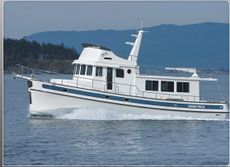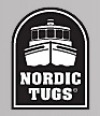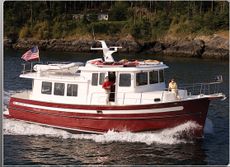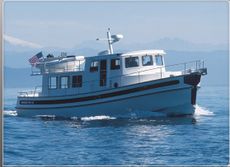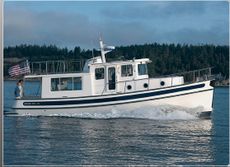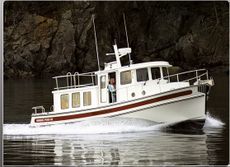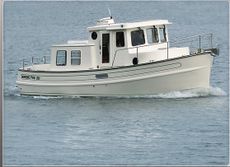Featured Advert! Click for more details and your nearest dealer
The birth of a classic.
The idea that grew to become today's Nordic Tugs had its origin in the fuel crisis of the mid-1970s: build a fuel-stingy vessel that combined the attributes important to the cruising powerboater. It proved to be one of those rare ideas not only appropriate for its time, but an idea whose virtues are still relevant today...
Our story begins in the early `70s, when Jerry Husted purchased Blue Water Boats, a company that manufactured double-ended ocean ketches of the Norwegian "Ingrid" design, from Jim Musser. Musser introduced Husted to Lynn Senour, the naval architect who designed the interiors and rigs of Musser's boat.
That combination of circumstances proved prophetic.
Featured Advert! Click for more details and your nearest dealer
The birth of a classic.
The idea that grew to become today's Nordic Tugs had its origin in the fuel crisis of the mid-1970s: build a fuel-stingy vessel that combined the attributes important to the cruising powerboater. It proved to be one of those rare ideas not only appropriate for its time, but an idea whose virtues are still relevant today...
Our story begins in the early `70s, when Jerry Husted purchased Blue Water Boats, a company that manufactured double-ended ocean ketches of the Norwegian "Ingrid" design, from Jim Musser. Musser introduced Husted to Lynn Senour, the naval architect who designed the interiors and rigs of Musser's boat.
That combination of circumstances proved prophetic.
Featured Advert! Click for more details and your nearest dealer
The idea that grew to become today's Nordic Tugs had its origin in the fuel crisis of the mid-1970s: build a fuel-stingy vessel that combined the attributes important to the cruising powerboater. It proved to be one of those rare ideas not only appropriate for its time, but an idea whose virtues are still relevant today...
Our story begins in the early `70s, when Jerry Husted purchased Blue Water Boats, a company that manufactured double-ended ocean ketches of the Norwegian "Ingrid" design, from Jim Musser. Musser introduced Husted to Lynn Senour, the naval architect who designed the interiors and rigs of Musser's boat.
Featured Advert! Click for more details and your nearest dealer
With the nostalgic appeal and notable fuel economy (1/2 gallon per hour at 6-1/2 knots), Nordic Tugs became an immediate success. Yachting Magazine had this to say about the innovative design, "There is something about a tugboat that makes people take to it instantly. Women want to mother it and grown men grin when they see one. Perhaps it's because so many of us learned to love `Lil Toot.` Tugs were always tubby, likeable characters, brightly painted and doers of heroic deeds."
Featured Advert! Click for more details and your nearest dealer
The idea that grew to become today's Nordic Tugs had its origin in the fuel crisis of the mid-1970s: build a fuel-stingy vessel that combined the attributes important to the cruising powerboater. It proved to be one of those rare ideas not only appropriate for its time, but an idea whose virtues are still relevant today...
Our story begins in the early `70s, when Jerry Husted purchased Blue Water Boats, a company that manufactured double-ended ocean ketches of the Norwegian "Ingrid" design, from Jim Musser. Musser introduced Husted to Lynn Senour, the naval architect who designed the interiors and rigs of Musser's boat.
That combination of circumstances proved prophetic.
Featured Advert! Click for more details and your nearest dealer
Nordic Tugs went on to build two versions of the original 26' design, originally named the Red Apple, a cruiser, and the Cricket, a short cabin, open-aft deck model used primarily as a fishing vessel. The two boats were presented at the Oakland Boat Show and over 18,000 people stopped by to check out the newest boating sensation.
The stylish, well-built boats with their fuel-efficient design and flexible cruising speeds proved to have lasting appeal. In 1982, the Northwest Marine Trade Association (NMTA) dubbed Nordic Tugs "one of the biggest success stories of a largely depressed pleasure boat construction scene."
1 Pages: 1

